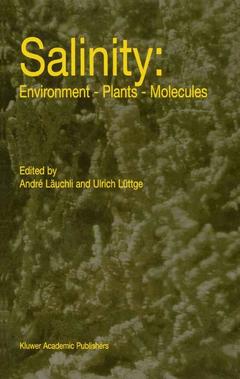Description
Salinity: Environment — Plants — Molecules, Softcover reprint of the original 1st ed. 2002
Coordinators: Läuchli André, Lüttge Ulrich
Language: English
Subjects for Salinity: Environment — Plants — Molecules:
Salinity: environment - plants molecules
Publication date: 03-2012
552 p. · 15.5x23.5 cm · Paperback
Publication date: 03-2012
552 p. · 15.5x23.5 cm · Paperback
Salinity : environment, plants, molecules
Publication date: 03-2002
552 p. · 15.5x23.5 cm · Hardback
Publication date: 03-2002
552 p. · 15.5x23.5 cm · Hardback
Description
/li>Contents
/li>
In biology, the very big global and thevery small molecular issues currently appear to be in the limelight ofpublic interest and research funding policies. They are in danger of drifting apart from each other. They apply very coarse and very fine scaling, respectively, but coherence is lost when the various intermediate levels of different scales are neglected. Regarding SALINITY we are clearly dealing with a global problem, which due to progressing salinization of arable land is of vital interest for society. Explanations and basic understanding as well as solutions and remedies may finally lie at the molecular level. It is a general approach in science to look for understanding of any system under study at the next finer (or "lower") level of scaling. This in itself shows that we need a whole ladder of levels with increasingly finer steps from the global impact to the molecular bases of SALINITY relations. It is in this vein that the 22 chapters of this book aim at providing an integrated view of SALINITY.
Acknowledgements. Introduction. A: Environment. 1. Global impact of salinity and agricultural ecosystems; M.G. Pitman, A. Läuchli. 2. Salinity in the soil environment; K.K. Tanji. 3. Salinity, halophytes and salt affected natural ecosystems; S.-W. Breckle. B: Organisms. 4. Adaptation of halophilic Archaea to life at high salt concentrations; A. Oren. 5. Adaptation of the haloterant alga Dunaliella to high salinity; U. Pick. 6. Mangroves; U. Lüttge. C: Mechanisms. 7. Ultrastructural effects of salinity in higher plants; H.-W. Koyro. 8. Intra- and inter-cellular compartmentation of ions - a study in specificity and plasticity; G. Wyn Jones, J. Gorham. 9. Salinity, osmolytes and compatible solutes; D. Rhodes, et al. 10. Sodium-calcium interactions under salinity stress; G.R. Cramer. 11. Salinity and nitrogen nutrition; W.R. Ullrich. 12. Pressure probe measurements of the driving forces for water transport in intact higher plants: effects of transpiration and salinity; U. Zimmermann, et al. 13. Salinity, growth and phytohormones; R. Munns. 14. The adaptive potential of plant development: evidence from the response to salinity; G.N. Amzallag. D: Photosynthesis. 15. Influence of salinity on photosynthesis of halophytes; C.E. Lovelock, M.C. Ball. 16. Performance of plants with C4-carboxylation modes of photosynthesis under salinity; U. Lüttge. 17. Induction of Crassulacean acid metabolism by salinity &endash; molecular aspects; H.J. Bohnert.E: Molecules. 18. Function of membrane transport systems under salinity: plasma membrane; L. Reinhold, M. Guy. 19. Function of membrane transport systems under salinity: tonoplast; M. Binzel, R. Ratajczak. 20. Genetics of salinity responses and plant breeding; J. Gorham, G.Wyn Jones. 21. Halotolerance genes in yeast; R. Serrano. 22. The long and winding road to haloterance genes; A. Maggio, et al. Index.
© 2024 LAVOISIER S.A.S.




